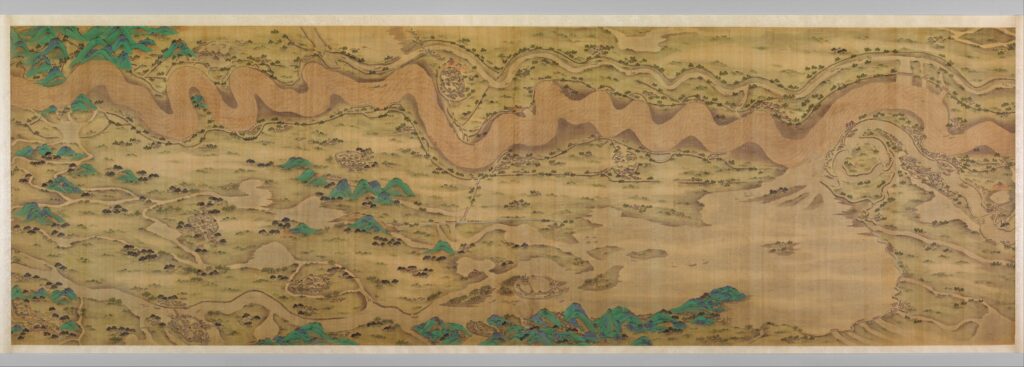This week’s text by David Allen Pietz revealed just how imperative the Yellow River is to China’s (and arguably, the entire globe’s) ecological and economic stability. What stood out to me most was Pietz’s claim that “coupled with demographic growth, which is projected to continue until 2050, economic expansion will test the environmental capacity of the North China Plain to sustain region and country.”[1]
While I’m sure that much of this week’s discussion will revolve around the Yellow River’s impact on the future of the environment (and rightfully so), I’d like to dive into artistic depictions of the Yellow River throughout history; we know that the river has visible environmental and economic impacts, but what is its greater cultural significance? A closer look at its representation in visual culture might prove helpful.

I’m especially drawn to a specific example at the Met in New York, dated from 1690-1722 by an unidentified artist. At more than forty-two feet long, Ten Thousand Miles along the Yellow River is a monumental work, and one of the grandest commissions of the Qing Dynasty. Unrolling from right to left, the viewer travels west from the sunrise over the Yellow Sea up to the High Mountains, where the river flows out of a narrow gorge known as The Dragon’s Scathe.
This work, one of the most intricately detailed maps created in traditional China, shows the intimate relationship between panoramic landscape painting and cartography. The patterned surface of the river appears flat, while the overlapping mountains create a sense of recession. Yet distances notably aren’t measurably. Towns on the near and far side of the river, for example, show no diminution in scale.
The Yellow River has long been called “China’s Sorrow.”[2] Up to sixty percent of its weight is made up of suspended silt from the fine soil blown off the Gobi Desert. When the river flows, the silt settles, and the riverbed’s height gradually rises. Consequently, a failure of the dikes restraining the river inevitably caused catastrophic flooding over thousands of miles of farmland. The history of Chinese rule is marked by constant efforts to regulate the river’s flow. A well-governed river, like the one shown here, is a symbol for a well-governed state.
I would be interested in camparing this work against other representations of the Yellow River. I recently saw headlines that the National Art Museum of China (中国美术馆) held an exhibition this past fall based around the river, but the number of credible sources regarding this show are limited. I would love to see contemporary artistic takes on the river, especially as we get closer to the impending ecological apocalypse—please let me know if you have any recommendations!
[1] Pietz, David Allen. 2015. The Yellow River: the problem of water in modern China, 12.
[2] Challenges in the Yellow River Basin (China): A Review.” Environmental Earth Sciences 75, no. 13 (2016): 1-20.